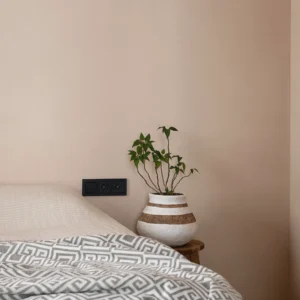A major shift in architecture: Natural and sustainable materials as the foundation of the future
Architecture has always been a reflection of humanity’s cultural and technological progress. However, in the current era, the field faces an urgent need for transformation. The environmental crisis has rendered traditional construction methods and materials obsolete, forcing architects and construction specialists to seek natural and sustainable alternatives.
One such solution is the use of natural mineral materials, with lime– and clay-based products standing out in particular. In this article, we explore why traditional oil-based paints and coatings should be replaced with natural alternatives and how materials like “UKU Natural Finish” can provide durability, quality, and sustainability.
Why do we need a change?
Today’s construction industry heavily relies on oil-based products, such as polymer paints and coatings. While these materials are readily available and versatile, they come with significant drawbacks:
- Environmental impact: Oil-based materials leave a large carbon footprint and are not biodegradable.
- Short lifespan: These materials require frequent maintenance and replacement, leading to increased waste.
- Poor indoor climate: Many oil-based products emit volatile organic compounds (VOC), which can degrade indoor air quality and pose health risks.
Using natural materials like lime and clay helps address these issues, offering a long-lasting and healthier alternative.
Lime and clay: Historical yet effective solutions
Lime and clay have been part of humanity’s construction practices for millennia, with their use documented as far back as ancient Egypt and Rome. Roman architect Vitruvius described lime as a durable and versatile material, which has been proven by numerous structures over 2,000 years old that still stand today. But what exactly makes these materials so special?
Lime as a binder
Lime is more than just a “glue” for dry materials—it forms a chemical bond that makes it exceptionally strong and durable. Hydraulic lime, for example, acts as an ideal binder, combining aggregate particles through a chemical process rather than simple drying.
Clay’s properties
Clay-based plasters are visually stunning and create a warm atmosphere. However, their fragility is a drawback—improperly processed clay is sensitive to moisture and quickly loses its structural integrity.
UKU Natural Finish: A Powerful Combination of Lime and Clay
A product like “UKU Natural Finish” sets a new standard in sustainable construction by combining the aesthetic qualities of clay with the structural strength of lime.
Its development considered all key factors:
- Zero emissions: UKU Natural Finish plasters do not emit harmful chemicals, thereby improving indoor air quality.
- Long lifespan: Unlike oil-based products that require frequent replacement, UKU Natural Finish is designed to last for decades.
- Environmentally friendly: Its production uses natural minerals that are abundant and renewable.

How does UKU natural finish work?
The unique composition of UKU Natural Finish includes hydraulic lime as a binder, ensuring the plaster’s strength and durability. Comparative water tests demonstrate:
- Conventional clay plaster: Absorbs water quickly and loses its structure.
- UKU natural finish: Absorbs minimal water and retains its strength, even in challenging conditions.
- Sustainability and the future
- The development of UKU natural finish placed a strong emphasis on sustainability. This not only involves a low carbon footprint during production but also long-term durability. A product that lasts decades significantly reduces material and energy waste.
In addition, UKU Natural Finish contributes to better indoor air quality, making it suitable for homes and workplaces alike. It is an ideal choice for both residential and commercial construction, creating healthier and more sustainable environments.
Climate and the UKU message
UKU Natural Finish, whose name cleverly combines “clay” and “lime,” also hints at its commitment to the climate. The product’s developers aim to highlight humanity’s impact on the climate and the need for a shift toward a more sustainable future. Every time we choose natural and sustainable materials, we reduce our footprint and contribute to environmental preservation.
The future of architecture lies in sustainable and natural materials
UKU Natural Finish is a prime example of how traditional materials like clay and lime can, with the help of modern technology, meet today’s demands. Its durability, aesthetics, and eco-friendliness make it an ideal choice for both homes and commercial buildings.
Shifting to natural and sustainable materials is not just a trend—it is the foundation of our future. By choosing products like UKU Natural Finish, we take a step forward in creating a more sustainable and healthier living environment. This is the change we need and a goal worth striving for.
Summary
Architecture urgently needs to focus on natural and sustainable materials like lime and clay. Traditional oil-based products are harmful to the environment, have a short lifespan, and worsen indoor air quality. UKU Natural Finish combines the aesthetics of clay with the durability of lime, offering a zero-emission, long-lasting, and eco-friendly solution. It is suitable for homes and commercial buildings alike, helping create a healthier and more sustainable future. UKU represents a new direction in architecture, built on quality and climate awareness.
